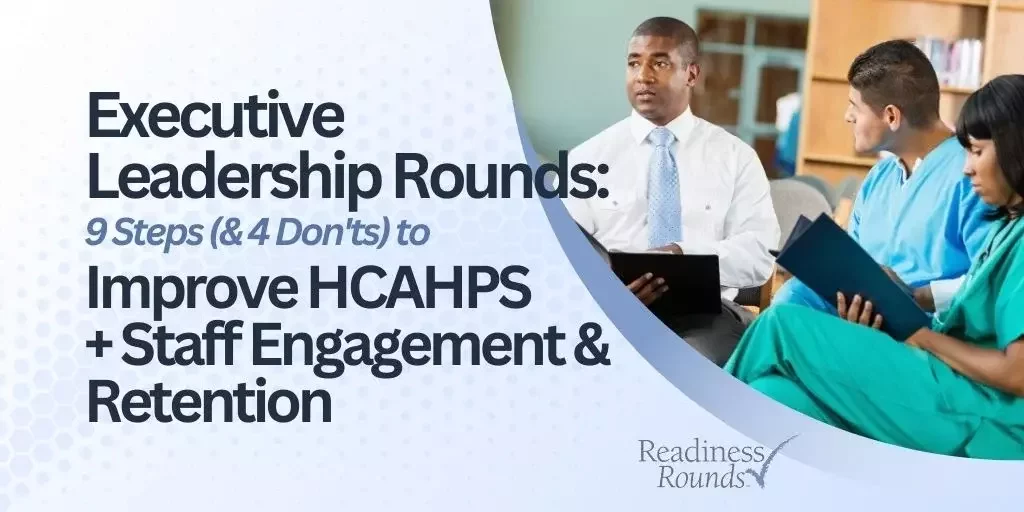
In hospitals, where patient experience is important and quality of care is non-negotiable, a subtle yet profound practice has emerged as a catalyst for positive change: Executive Leadership Rounds.
This powerful initiative, often overlooked amidst the hustle and bustle of hospital operations, holds the potential to support the transformation of HCAHPS patient experience scores, breathing new life into the patient relationship while driving operational excellence.
In this post, we delve into the critical importance of how sustained leadership rounds positively impact HCAHPS scores and patient satisfaction, improve staff satisfaction & retention, and contribute to improving care outcomes.
The Significance of Executive Leadership Rounds in Hospitals:

Executive Leadership Rounding is a purposeful approach, allowing senior leaders to connect directly with staff.
Through meaningful interactions, these rounds encourage open communication, empathy, and accountability, leading to improved staff satisfaction and retention along with a clear and objective understanding of staff improvement priorities.
What You Can Expect to Takeaway from this Blog Post:
We will navigate the multifaceted landscape of Executive Leadership Rounds by covering the following:
- Unpacking Leadership Rounds: We'll discuss the core concept of Senior Leadership Rounds, explaining its underlying principles and shedding light on how it bridges the gap between leadership, staff, and patients.
- The HCAHPS Connection: Discover how Leadership Rounds align with and positively influence HCAHPS scores, enriching patient satisfaction and experience indicators.
- 9 Strategies for Effective Implementation: We'll provide actionable insights on how to effectively institute Leadership Rounds, offering practical steps and best practices to ensure seamless integration into your hospital setting.
- What Not To Do: Crucially, we’ll also provide valuable insights on what to avoid while planning and implementing Executive Leadership Rounds in your hospital.
Unpacking Leadership Rounds:
Leadership Rounds is a dynamic practice in hospitals that brings leaders, staff, and together.
Leadership Rounds are designed to create a space for open conversations between leadership and staff, shared understanding, and everyone taking responsibility.
The primary objective of consistently having executives receive direct feedback from staff is to ensure that the staff has the tools and support needed to deliver exceptional patient care and provide a high-quality patient experience.
The HCAHPS Connection:

9 Strategies for Effective Implementation:
1. Get Unified Support
2. Visit All Staff & All Departments
3. Create Time Allocation
4. Leverage Technology
5. Create a Structured Process for all Senior Leaders to Follow
6. Use All Staff & All Department
- Make sure everyone understands the frequency with which they are expected to conduct rounds—weekly for 45 minutes.
- Start on time and finish on time.
- Don’t cancel or reschedule. Canceling or rescheduling transmits to staff that their time is not valuable.
- Include evenings, nights and weekends.
- Decide whether managers should participate or whether the staff would feel freer to speak without their manager being present. Ideally meet with staff without the manager present.
- Review the last two or three visits to see what previous items have been discussed. See if they come up again as a recurring item for this department.
- Provide feedback on any changes or solutions that were developed based on previous rounds.
- Don’t lecture. Don’t be condescending. Check your ego at the door.
- The leader should take up no more than 20% of the talking time.
- Keep meetings small. More than 10 employees in a meeting and you will not get any meaningful interactions.
- If employee numbers are an issue, insist that the department manager figure out how to rotate staff through the meeting. Have all attendees participate. Some staff will be intimidated and will need gentle coaxing to join the discussion. For staff who are reluctant to participate, ask them an easy question (e.g. John, are there any obstacles to doing your job?).
- Don’t be afraid to take notes. Without taking notes you will never be able to follow-up on items that are discussed.
- Finish all write-ups of meetings before you leave the department or unit. Ideally, you have the technology to enter into a rounding tool on your smartphone or tablet that will automatically generate follow-up actions for identified issues. If you leave the department without doing so, the accuracy of what you produce will drop at least 50% and you are in real danger of not getting items taken care of at all.
- Secure unanimous commitment from the senior team to initiate performance improvement initiatives targeting areas identified with high failure rates.
- Conduct a group training session for executives to discuss, enhance, and agree on approach.
- Have a “coach” go with each leader on their first meeting and then at least once a year
7. The “If Yes” Technique
- Steer clear of any form of interrogation or testing.
- Encourage open conversations. You may uncover issues that did not initially surface. Or you may get strong reinforcement of existing approaches. Either way the information is incredibly valuable.
- To leverage the “If Yes” approach, be prepared with exploration questions for instances when the staff response is "Yes, everything is fine."
- Make sure you have scripted follow-up questions to support the process. Through the “If Yes” technique, you can potentially uncover underlying issues that staff might not have been initially ready to discuss. Conversely, if effective communication methods are confirmed, this approach further reinforces the value of good communication practices.
8. Effective Follow-Up
9. Sustainable Performance Improvement
Ensure the Senior Team is committed to taking PI action on the results of their efforts. Without effective PI efforts at least 50% of the benefit of this approach is lost.
Performance Improvement hinges upon the unwavering commitment of the senior leadership team to initiate improvement endeavors against identified issues.
Ensure the Senior team has and is coached on their findings and possible PI priorities. Ensure Department Managers have full access to their department results.
While sharing anecdotal accounts and swiftly addressing departmental concerns holds value, their impact remains short-lived. Anecdotes cannot fuel enduring performance enhancement. Tracking and using PI data is where the long-term improvements are made.
While some challenges will have straightforward solutions, others may prove intricate. An objective yardstick rooted in staff feedback and a method to prioritize endeavors becomes essential to prevent overwhelming the team and encountering setbacks.
Be sure you have a strong process and supporting technology in place to deploy effective performance improvement.

4 Approaches that Will Almost Certainly Ensure Failure:
1. Lack Of Executive Commitment
2. Not Automating the Process
Without automation the process will most likely collapse under the volume of the data. Manual production of schedules, checklists, follow-up and data analysis for PI quickly become overwhelming tasks that cannot be sustained
over time.
See how we support our hospital clients with all-digital, all-automated performance improvement.
3. No Performance Improvement Efforts
Unless the rounding results are used to implement meaningful, measurable and visible performance improvement it is difficult to keep senior leaders engaged over time.
4. Executives Rounding As a Team
Do not conduct in teams, instead assign individual leaders to departments. Rounding as a team intimidates the staff, significantly reduces coverage, and creates endless scheduling issues and excuses.
Key Takeaways:
- Elevating HCAHPS Scores Through Leadership Rounds:
Implementing structured Leadership Rounds can significantly impact HCAHPS scores by fostering open communication, empathy, and accountability between leadership, and staff. Remember if senior staff want to visit patients, that can be worthwhile for their engagement but it will not improve patient experience. The volume and daily effort required is simply beyond their personal bandwidth. The senior leader's task is to ensure that staff have the tools and support they need to consistently deliver high quality care and experience. - The Power of Structured Approach:
A well-structured approach to Leadership Rounds is vital for sustainability and success. Senior executives should allocate time, engage all departments, and ensure automated processes for scheduling, follow-up, and reporting. - Inclusive Engagement:
Extend Leadership Rounds beyond clinical staff to include housekeepers, security officers, and non-patient areas. In other words: everyone. Use the “If Yes” technique to prompt meaningful discussions. - Training and Technology Integration:
Provide formal training for senior leaders on effective rounding techniques. Incorporate technology for automated follow-up and reporting processes to ensure accountability and continuous improvement. - Driving Performance Improvement:
Gain senior leadership commitment to launch improvement efforts based on identified issues. Objective measures, prioritization, and supporting technology are crucial for driving sustainable performance improvement. Without ongoing, meaningful performance improvement it is unlikely the process will be sustainable. - Engagement and Empowerment:
Leadership Rounds create a positive environment, build enthusiasm, and foster trust among staff, contributing to a patient-centered and quality-focused healthcare.
Readiness Rounds supports our clients through their Executive Leadership Rounding processes and their performance improvement initiatives. We would be delighted to be a partner in your patient satisfaction improvement journey. We’re here to chat anytime.
Curious to see the rest of the Readiness Rounds Patient Satisfaction Approach looks like?
At Readiness Rounds, we’ve developed a proven approach to improving Patient Satisfaction and Experience. We call it the 9 Approaches. Watch the short video series here.
We’ve also put together a free 24-page step-by-step proven approach to improving patient satisfaction. You can get your free copy of the 17 Proven Strategies to Improve Patient Satisfaction here.

